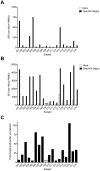Non-immunogenicity of overlapping gag peptides pulsed on autologous cells after vaccination of HIV infected individuals
- PMID: 24124451
- PMCID: PMC3790804
- DOI: 10.1371/journal.pone.0074389
Non-immunogenicity of overlapping gag peptides pulsed on autologous cells after vaccination of HIV infected individuals
Abstract
Background: HIV Gag-specific CD4+ and CD8+ T-cell responses are important for HIV immune control. Pulsing overlapping Gag peptides on autologous lymphocytes (OPAL) has proven immunogenic and effective in reducing viral loads in multiple pigtail macaque studies, warranting clinical evaluation.
Methodology: We performed a phase I, single centre, placebo-controlled, double-blinded and dose-escalating study to evaluate the safety and preliminary immunogenicity of a novel therapeutic vaccine approach 'OPAL-HIV-Gag(c)'. This vaccine is comprised of 120 15mer peptides, overlapping by 11 amino acids, spanning the HIV Gag C clade sequence proteome, pulsed on white blood cells enriched from whole blood using a closed system, followed by intravenous reinfusion. Patients with undetectable HIV viral loads (<50 copies/ml plasma) on HAART received four administrations at week 0, 4, 8 and 12, and were followed up for 12 weeks post-treatment. Twenty-three people were enrolled in four groups: 12 mg (n = 6), 24 mg (n = 7), 48 mg (n = 2) or matching placebo (n = 8) with 18 immunologically evaluable. T-cell immunogenicity was assessed by IFNγ ELIspot and intracellular cytokine staining (ICS).
Results: The OPAL-HIV-Gag(c) peptides were antigenic in vitro in 17/17 subjects. After vaccination with OPAL-HIV-Gag(c), 1/6 subjects at 12 mg and 1/6 subjects at 24 mg dose groups had a 2- and 3-fold increase in ELIspot magnitudes from baseline, respectively, of Gag-specific CD8+ T-cells at week 14, compared to 0/6 subjects in the placebo group. No Gag-specific CD4+ T-cell responses or overall change in Rev, Nef, Tat and CMV specific responses were detected. Marked, transient and self-limiting lymphopenia was observed immediately post-vaccination (4 hours) in OPAL-HIV-Gag(c) but not in placebo recipients, with median fall from 1.72 to 0.67 million lymphocytes/mL for active groups (P<0.001), compared to post-placebo from 1.70 to 1.56 lymphocytes/ml (P = 0.16).
Conclusion/significance: Despite strong immunogenicity observed in several Macaca nemestrina studies using this approach, OPAL-HIV-Gag(c) was not significantly immunogenic in humans and improved methods of generating high-frequency Gag-specific T-cell responses are required.
Name of registry: ClinicalTrials.gov, Registry number: NCT01123915, URL trial registry database: http://www.clinicaltrials.gov/ct2/results?term=OPAL-HIV-1001&Search=Search.
Conflict of interest statement
Figures






References
-
- Kiepiela P, Ngumbela K, Thobakgale C, Ramduth D, Honeyborne I, et al. (2007) CD8+ T-cell responses to different HIV proteins have discordant associations with viral load. Nat Med 13: 46–53. - PubMed
Publication types
MeSH terms
Substances
Associated data
LinkOut - more resources
Full Text Sources
Other Literature Sources
Medical
Research Materials

